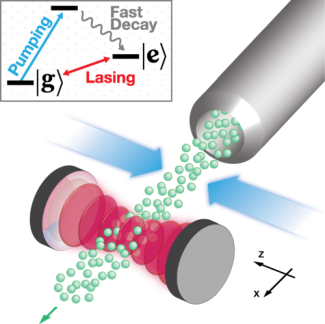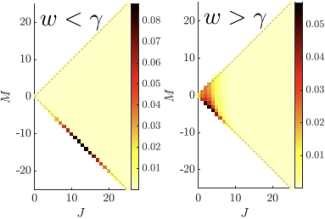Comparison of a traditional laser to a superradiant laser. Since, in the latter case, the phase information is stored in the atoms, superradiant lasers can be significantly more robust to thermal vibrations of the mirrors.
Proposal for a thermal beam setup in order to achieve continuous-wave superradiant lasing.
State populations in the Dicke basis for states on either side of the subradiant-to-subradiant phase transition in the bad-cavity lasing model.
Our research group is on the quest for the holy grail: an active superradiant atomic clock. Such clocks are so desirable for both practical and scientific reasons, and have the potential to push the precision of clock measurements to levels in which quantum gravitational effects can be studied. For one, the use of superradiant lasers instead of traditional lasers can greatly improve the phase coherence in the optical field of the clock system. This is because the system operates in the bad-cavity regime such that the output light is directly emitted from an ultra-narrow clock transition. By developing an active atomic clock based on this system, clock setups would no longer need additional probe lasers which restrict current experiments from exploiting the full potential offered by the stability of optical clock transitions. This could potentially achieve a lasing linewidth on the order of mHz which corresponds to a coherence length stretching from the Earth to the Sun. Furthermore, since the phase coherence of the output field is stored in the atoms rather than the cavity photons, the system becomes incredibly robust to thermal fluctuations of the reference cavity mirrors which is the main effect that limits the achievable linewidth in traditional lasers.
Our group, in collaboration with the Ye lab, pioneered the idea of active superradiant atomic clocks in a trapped atom bad-cavity system. This proposal introduced an individual pumping scheme which allows the system to avoid problems from single-atom decoherence processes that would ruin previous proposals of fully collective superradiant lasers. The use of individual pumping also significantly expands the parameter regime in which steady-state superradiance is achievable compared to fully collective superradiant lasers. With this proposed model, our group collaborated with the Thompson lab to achieve the first experimental realization of a superradiant laser. However, experimental realizations of superradiant lasers have so far been limited to the pulsed regime primarily due to atomic heating effects associated with the individual pumping scheme. To overcome these practical issues and achieve continuous-wave lasing, our group, in collaboration with the Nicholson lab out of the Center for Quantum Technologies in Singapore, have instead proposed a thermal beam configuration where atoms are excited before traversing the cavity mode. We collaborate with the Schreck lab from the University of Amsterdam to realize our thermal beam proposal in an experimental setting.
In addition to superradiant lasing, we research bad-cavity QED in the context of dissipative phase transitions and entanglement-enhanced metrology. We have explored the weak-pumping regime of the bad-cavity laser model in which we discovered a fully dissipative phase transition between two distinctive states of steady-state subradiance. This system has a vanishing number of unentangled atoms near the critical point in the large atom limit. We also examine systems where highly entangled states can be adiabatically created in a decoherence-free subspace of collective dissipation induced by the decay of the cavity.





 The Physics Frontiers Centers (PFC) program supports university-based centers and institutes where the collective efforts of a larger group of individuals can enable transformational advances in the most promising research areas. The program is designed to foster major breakthroughs at the intellectual frontiers of physics by providing needed resources such as combinations of talents, skills, disciplines, and/or specialized infrastructure, not usually available to individual investigators or small groups, in an environment in which the collective efforts of the larger group can be shown to be seminal to promoting significant progress in the science and the education of students. PFCs also include creative, substantive activities aimed at enhancing education, broadening participation of traditionally underrepresented groups, and outreach to the scientific community and general public.
The Physics Frontiers Centers (PFC) program supports university-based centers and institutes where the collective efforts of a larger group of individuals can enable transformational advances in the most promising research areas. The program is designed to foster major breakthroughs at the intellectual frontiers of physics by providing needed resources such as combinations of talents, skills, disciplines, and/or specialized infrastructure, not usually available to individual investigators or small groups, in an environment in which the collective efforts of the larger group can be shown to be seminal to promoting significant progress in the science and the education of students. PFCs also include creative, substantive activities aimed at enhancing education, broadening participation of traditionally underrepresented groups, and outreach to the scientific community and general public.